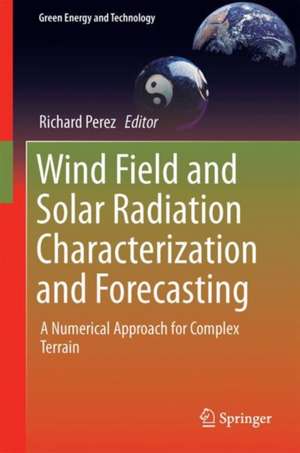Wind Field and Solar Radiation Characterization and Forecasting: A Numerical Approach for Complex Terrain: Green Energy and Technology
Editat de Richard Perezen Limba Engleză Hardback – 7 mai 2018
In addition to describing core concepts and principles, this book reveals professional methodologies and tools used by national agencies and private corporations to predict sites’ potential for wind and solar power generation. Each chapter focuses on a different issue, showing readers the corresponding methodology, as well as examples of how to apply the techniques described. These techniques are explained with step-by-step guides that demonstrate how environmental variables in complex terrains can be characterized and forecasted.
The authors present an adaptive finite element mass-consistent model, which computes a diagnostic wind field in the three-dimensional area of interest using observed wind data from measurement stations – data which is then interpolated using a physical model of the wind field in the boundary layer. An ensemble method is presented based on the perturbation of the numerical weather prediction models’ results.
The book goes on to explain solar radiation characterization and forecasting. Solar radiation and electrical power generation temporal and spatial variability are discussed and modelled. Different statistical methods are presented in order to improve solar radiation forecasting using ground measurement, numerical weather predictions (NWPs) and satellite-derived data. This book is focused on both probabilistic and point forecast explaining different models and methodologies to improve the forecasting. The results obtained from various simulations around the world are presented in tables. Finally, the book explains a possible methodology to develop a Solar Map taking into account solar radiation, terrain surface conditions and cast shadows.
As such, the book provides an overview of the concepts, principles and practices involved in the treatment of environmental variables related to solar radiation or wind fields, especially when complex terrains are involved, offering useful resources for students and researchers alike. It also equips professionals with the methodologies and tools needed to construct environmental variable maps and conduct forecasting for solar radiation and wind fields.
| Toate formatele și edițiile | Preț | Express |
|---|---|---|
| Paperback (1) | 639.41 lei 6-8 săpt. | |
| Springer International Publishing – 26 ian 2019 | 639.41 lei 6-8 săpt. | |
| Hardback (1) | 645.60 lei 6-8 săpt. | |
| Springer International Publishing – 7 mai 2018 | 645.60 lei 6-8 săpt. |
Din seria Green Energy and Technology
- 18%
 Preț: 943.43 lei
Preț: 943.43 lei - 20%
 Preț: 629.52 lei
Preț: 629.52 lei - 18%
 Preț: 1124.92 lei
Preț: 1124.92 lei - 18%
 Preț: 947.35 lei
Preț: 947.35 lei - 15%
 Preț: 655.92 lei
Preț: 655.92 lei - 18%
 Preț: 957.62 lei
Preț: 957.62 lei - 18%
 Preț: 789.52 lei
Preț: 789.52 lei - 17%
 Preț: 464.56 lei
Preț: 464.56 lei - 15%
 Preț: 645.79 lei
Preț: 645.79 lei - 18%
 Preț: 903.93 lei
Preț: 903.93 lei - 24%
 Preț: 1322.09 lei
Preț: 1322.09 lei - 18%
 Preț: 890.54 lei
Preț: 890.54 lei - 18%
 Preț: 1115.46 lei
Preț: 1115.46 lei - 18%
 Preț: 1117.03 lei
Preț: 1117.03 lei - 18%
 Preț: 949.73 lei
Preț: 949.73 lei - 18%
 Preț: 892.11 lei
Preț: 892.11 lei - 15%
 Preț: 648.24 lei
Preț: 648.24 lei - 18%
 Preț: 997.09 lei
Preț: 997.09 lei - 15%
 Preț: 579.81 lei
Preț: 579.81 lei - 18%
 Preț: 1123.15 lei
Preț: 1123.15 lei - 18%
 Preț: 961.41 lei
Preț: 961.41 lei - 17%
 Preț: 490.23 lei
Preț: 490.23 lei - 18%
 Preț: 904.60 lei
Preț: 904.60 lei - 15%
 Preț: 643.34 lei
Preț: 643.34 lei -
 Preț: 287.91 lei
Preț: 287.91 lei - 24%
 Preț: 634.05 lei
Preț: 634.05 lei -
 Preț: 379.40 lei
Preț: 379.40 lei - 18%
 Preț: 783.20 lei
Preț: 783.20 lei - 18%
 Preț: 956.09 lei
Preț: 956.09 lei - 18%
 Preț: 1394.84 lei
Preț: 1394.84 lei - 18%
 Preț: 1691.57 lei
Preț: 1691.57 lei - 15%
 Preț: 592.61 lei
Preț: 592.61 lei - 18%
 Preț: 952.09 lei
Preț: 952.09 lei - 18%
 Preț: 944.19 lei
Preț: 944.19 lei - 18%
 Preț: 891.33 lei
Preț: 891.33 lei - 18%
 Preț: 1252.44 lei
Preț: 1252.44 lei - 18%
 Preț: 789.52 lei
Preț: 789.52 lei - 20%
 Preț: 566.30 lei
Preț: 566.30 lei - 18%
 Preț: 1112.48 lei
Preț: 1112.48 lei - 18%
 Preț: 1114.24 lei
Preț: 1114.24 lei - 18%
 Preț: 1113.71 lei
Preț: 1113.71 lei - 18%
 Preț: 1011.45 lei
Preț: 1011.45 lei - 24%
 Preț: 590.60 lei
Preț: 590.60 lei - 20%
 Preț: 567.50 lei
Preț: 567.50 lei - 24%
 Preț: 907.50 lei
Preț: 907.50 lei - 18%
 Preț: 952.89 lei
Preț: 952.89 lei
Preț: 645.60 lei
Preț vechi: 759.54 lei
-15% Nou
Puncte Express: 968
Preț estimativ în valută:
123.53€ • 134.61$ • 104.10£
123.53€ • 134.61$ • 104.10£
Carte tipărită la comandă
Livrare economică 23 aprilie-07 mai
Preluare comenzi: 021 569.72.76
Specificații
ISBN-13: 9783319768755
ISBN-10: 3319768751
Pagini: 247
Ilustrații: XVI, 257 p. 120 illus., 96 illus. in color.
Dimensiuni: 155 x 235 mm
Greutate: 0.56 kg
Ediția:1st ed. 2018
Editura: Springer International Publishing
Colecția Springer
Seria Green Energy and Technology
Locul publicării:Cham, Switzerland
ISBN-10: 3319768751
Pagini: 247
Ilustrații: XVI, 257 p. 120 illus., 96 illus. in color.
Dimensiuni: 155 x 235 mm
Greutate: 0.56 kg
Ediția:1st ed. 2018
Editura: Springer International Publishing
Colecția Springer
Seria Green Energy and Technology
Locul publicării:Cham, Switzerland
Cuprins
Part I: Analysis and Characterization of Geographical and Meteorological Data.- Part II: Wind Field Diagnostic and Forecasting.- Part III: Solar Radiation Diagnostic and Forecasting.
Notă biografică
Richard Pérez directs solar energy research at U. Albany’s Atmospheric Sciences Research Center. He sits on the Advisory Board of George Washington University’s Solar Institute and has served multiple terms on the board of the American Solar Energy Society and as an associate editor of Solar Energy Journal. He has produced over 250 journal articles, book chapters and conference papers.
Textul de pe ultima copertă
In addition to describing core concepts and principles, this book reveals professional methodologies and tools used by national agencies and private corporations to predict sites’ potential for wind and solar power generation. Each chapter focuses on a different issue, showing readers the corresponding methodology, as well as examples of how to apply the techniques described. These techniques are explained with step-by-step guides that demonstrate how environmental variables in complex terrains can be characterized and forecasted.
The authors present an adaptive finite element mass-consistent model, which computes a diagnostic wind field in the three-dimensional area of interest using observed wind data from measurement stations – data which is then interpolated using a physical model of the wind field in the boundary layer. An ensemble method is presented based on the perturbation of the numerical weather prediction models’ results.
The book goes on to explain solar radiation characterization and forecasting. Solar radiation and electrical power generation temporal and spatial variability are discussed and modelled. Different statistical methods are presented in order to improve solar radiation forecasting using ground measurement, numerical weather predictions (NWPs) and satellite-derived data. This book is focused on both probabilistic and point forecast explaining different models and methodologies to improve the forecasting. The results obtained from various simulations around the world are presented in tables. Finally, the book explains a possible methodology to develop a Solar Map taking into account solar radiation, terrain surface conditions and cast shadows.
As such, the book provides an overview of the concepts, principles and practices involved in the treatment of environmental variables related to solar radiation or wind fields, especially when complex terrains are involved, offering useful resources for students and researchers alike. It also equips professionals with the methodologies and tools needed to construct environmental variable maps and conduct forecasting for solar radiation and wind fields.
Caracteristici
Gives readers the tools needed to analyze and predict the potential of sites for both wind and solar power generation Includes wind-field analysis and forecasting Introduces a method for generating 3D geographical maps with both wind fields and solar radiation forecasting






















